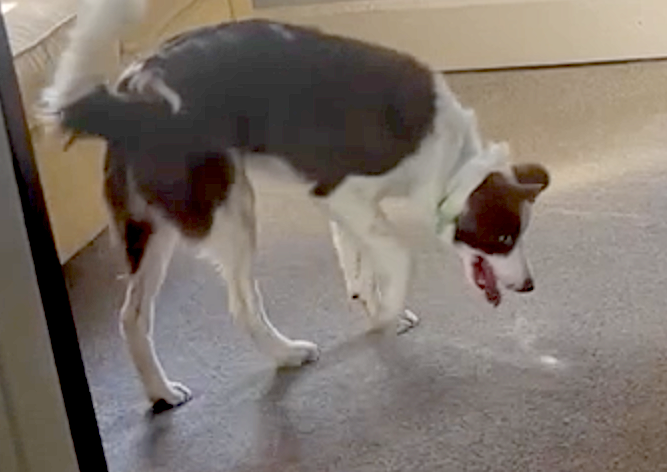Daphne’s owners contacted me back in August 2022. Daphne was only 5 months old at the time, and had recently started chasing shadows. She had very quickly worsened to chasing shadows for up to 90% of the time that she was awake. She would also repetitively run up and down the garden without focusing on anything obvious and would occasionally snap at nothing in the air (a behaviour known as fly snapping). When she performed these behaviours, she was very difficult to distract, and rarely relaxed, went to her owners for fuss, or did her usual doggy passtimes in the house and garden.
Her behaviour at the weekends was the worst because her owners were there all day with her, so she wasn’t getting any rest or time on her own to calm down, unless they put her in her crate. In the week, she was ok in the mornings before her owners went to work. She would start to spin at lunch times when they returned home for a couple of hours, then in the evening the shadow chasing became very severe in both frequency and intensity for most of the evening until she collapsed at about 10pm.
The behaviour had started, as is so often the case, when Daphne chased her owner’s watch reflections. They thought it was funny to start with, but then quickly stopped encouraging it. But over 5 weeks the shadow chasing worsened very quickly. This is typical with border collies. In the following video, you can see that even when the lights are turned off, she can still pick out enough light/shadow patterns on the floor to fixate on.
Behaviour and training plan
Note that the following training plan won’t work for all shadow chasing cases. The treatment depends on the motivations and emotions behing the behaviour.
Because the weekends were more difficult to manage, we started working on the weekdays first. Daphne’s owners had to find 4 hours’ worth of activities to give Daphne to PRE-EMPT the shadow chasing in the evenings when it was at its worse. Which, when you break it down into different activities, a walk, crate time and time in the garden, isn’t as bad as it sounds. They prepared several enrichment activities (see my border collie enrichment post) in advance each day. When they knew the shadow chasing was about to start – usually when they returned home from work, they had an acitivty ready to give her straight away. As soon as she had finished, they took her out into the garden for a wee, then back inside to the next acitivity. Again, when that was finished, she went back outside, then had a few minutes in her crate with a licking-type activity. Her crate had a cover over it so that there were no shadows. This gave her a chance to relax for 15 minutes. Then she would come out for another activity, then out into the garden, and so on.
At some point each evening they took her out for a walk, and had half an hour’s training as well, at a separate time in the evening. Luckily Daphne didn’t chase shadows on walks, so she would come back home to another activity, and so on until she fell asleep at 10pm. Her owners found this manageable and the shadow chasing started to reduce.
This is an example schedule that they used:
1. Bone for as long as it takes her to start getting bored, then put it away before she really loses interest.
2. Crate with snuffle mat
3. Evening walk
4. Crate with lickimat
5. Training – usual training plus scent training
6. Crate with kong
7. Play/training with flirt pole
8. Crate with snuffle mat
9. Cardboard box free play (hidden treats etc)
10. Crate with lickimat
11. Training – usual training with mat training
12. Crate with kong
I also worked with Daphne’s vet and she was prescribed medication to help lower her anxiety, arousal and impulsivity, all of which make shadow chasing worse.
After 8 weeks, Daphne’s shadow chasing had declined to about 20% of the time, and in the next few weeks it declined further to chasing shadows at about 10% of the time, a huge improvement from 90%. The weekends fell into place quite easily, with Daphne’s owners taking her out a lot into open spaces, where she didn’t chase shadows, but managed her time at home with enrichment activities really well.
When I last spoke to her owners, Daphne was still occasionally chasing shadows (which often happens – shadow chasers are like alcoholics – they will always have the tendency to chase shadows, and need to be managed more closely) but it was manageable and no longer took over her life.
This video shows the pacing up and down with fly snapping in the garden:
Because Daphne didn’t chase shadows when she was left alone, and didn’t do it when out on walks, I suspect that a lot of Daphne’s shadow chasing behaviour was attention-seeking. This is especially likely because she first started the behaviour while watching watch reflections, which her owners encouraged to start with. So by ignoring the shadow chasing and whenever possible pre-empting it with enrichment activities, she was learning that interacting with her owners earned her more attention than the shadow chasing and she was kept fully occupied. This is why PRE-EMPTING the shadow chasing was important – so that she didn’t use the shadow chasing behaviour to initiate the rewarding enrichment activities.

